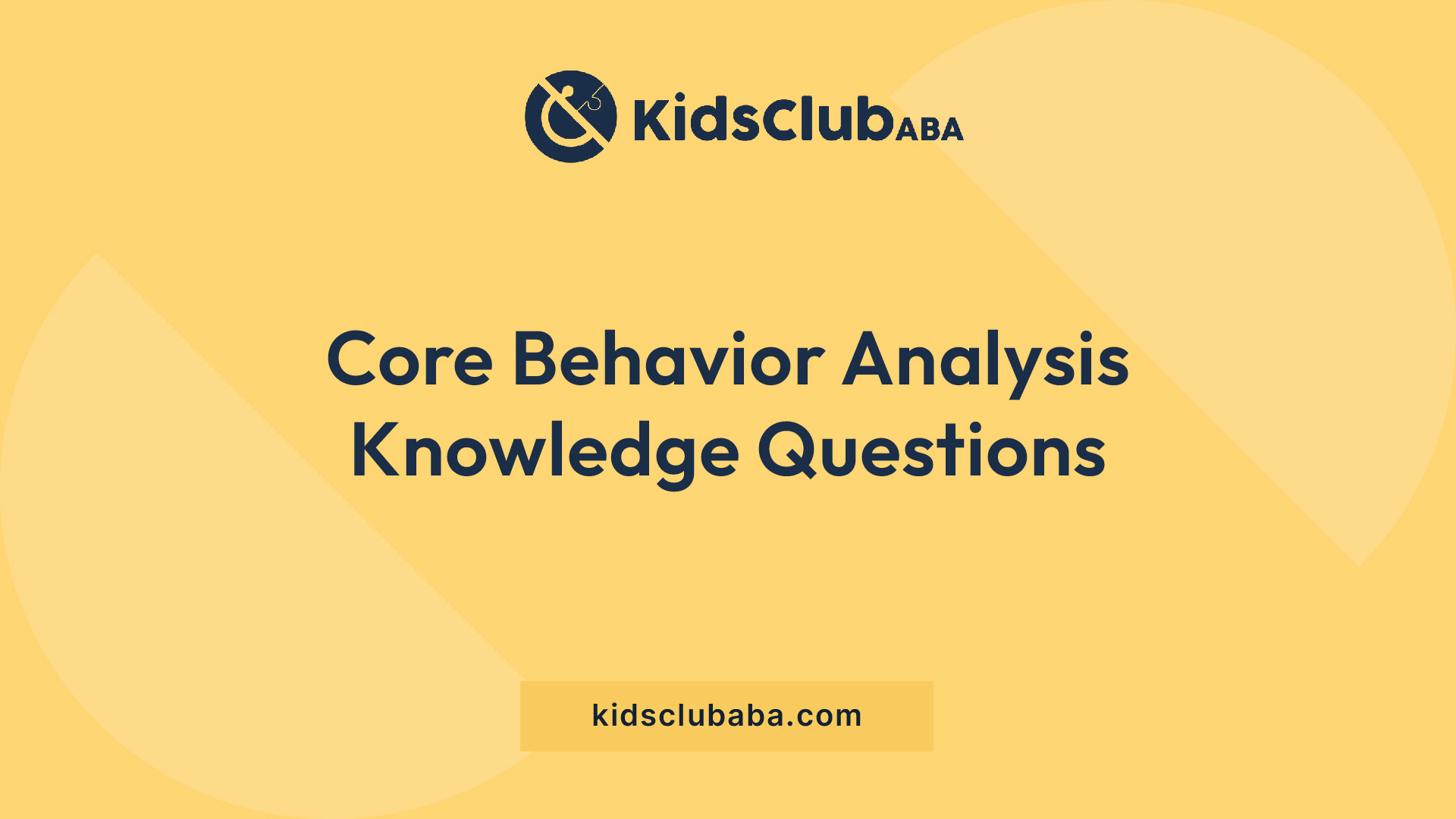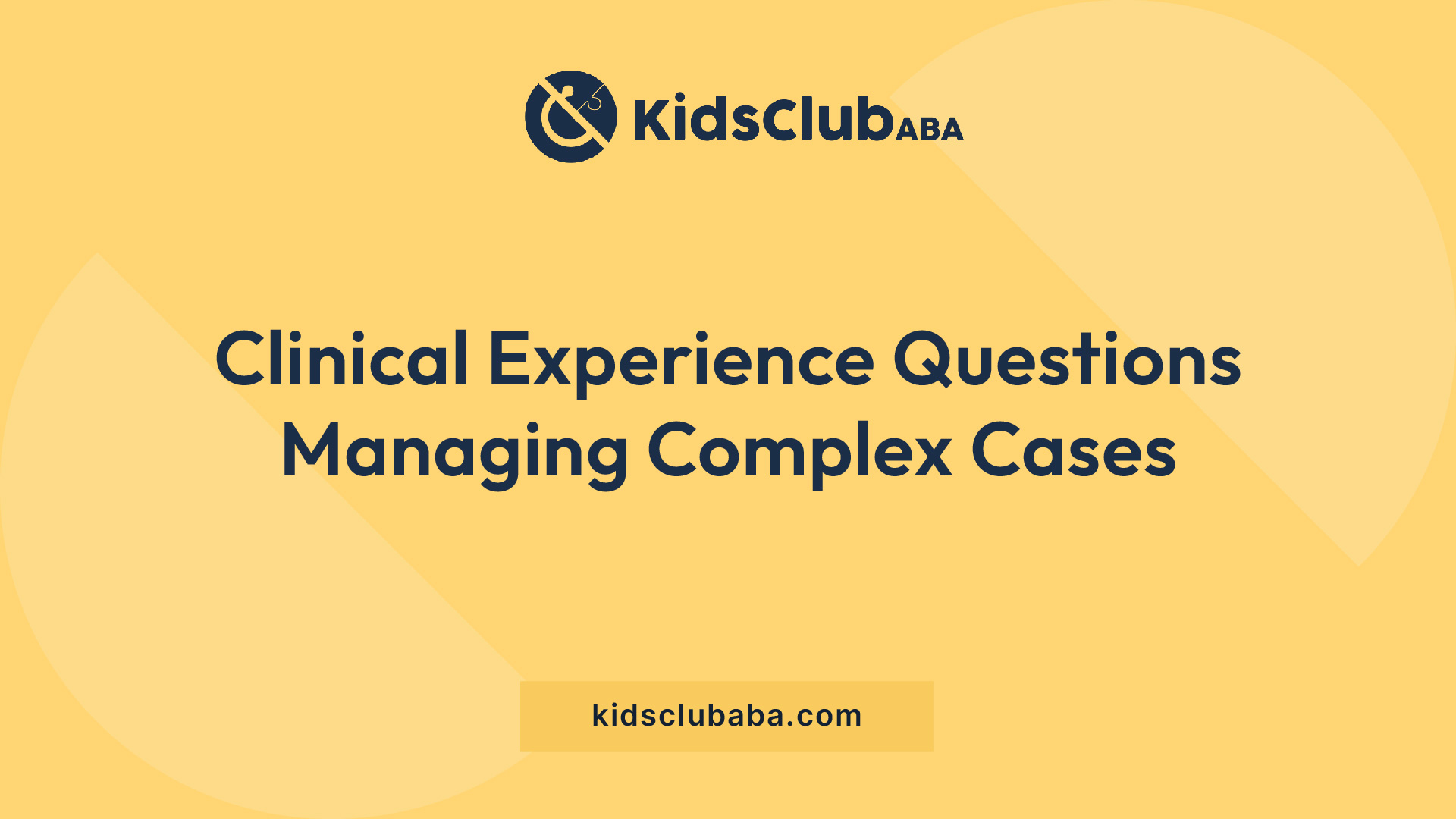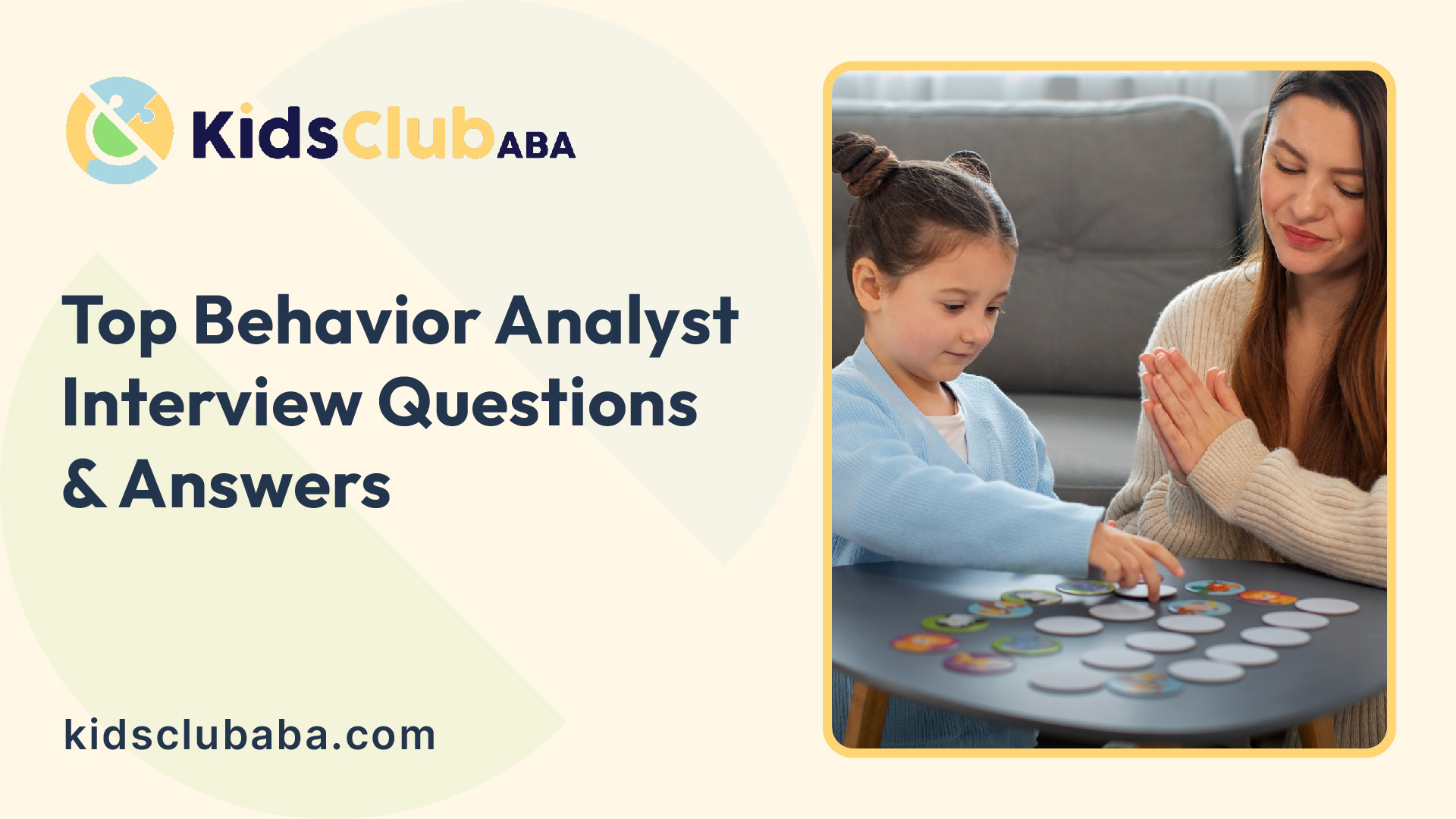Table of Contents
ToggleIntroduction
The field of applied behavior analysis continues to grow rapidly. The U.S. Bureau of Labor Statistics projects a 22% increase in behavior analyst positions through 2031. This growth rate far exceeds the average for most occupations. Organizations now recognize the value of behavior analysis across healthcare, education, and corporate settings. This recognition has intensified competition for these specialized roles.
Are you a recent graduate with a new BCBA certification? Or perhaps an experienced analyst seeking career advancement? Either way, preparing for field-specific interview questions is essential. This guide will help you craft effective responses to common behavior analyst interview questions. You’ll learn how to showcase your expertise and professional philosophy.
Core Behavior Analysis Knowledge Questions

1. “Can you explain the core principles of applied behavior analysis?”
Strong Answer: “Applied Behavior Analysis focuses on behavior as its primary subject matter. It emphasizes how environmental variables influence behavior. The field relies on behavioral contingencies including antecedents and consequences. We systematically manipulate these variables to produce meaningful behavior change.
ABA is fundamentally analytical. It requires clear demonstration of functional relationships between interventions and behavior changes. We prioritize technological precision in our interventions. Our approaches maintain conceptual consistency with established behavioral principles. We measure effectiveness by meaningful outcomes.
The field emphasizes generality. This means ensuring behavior changes last across different settings, behaviors, and time. Baer, Wolf, and Risley outlined these principles in 1968. They continue to guide evidence-based practice today.”
Why This Works: This answer shows deep knowledge of foundational ABA principles. It references important literature in the field. The candidate demonstrates both theoretical understanding and practical awareness.
Understanding Behavioral Concepts
2. “How would you explain positive and negative reinforcement to someone with no behavior analysis background?”
Strong Answer: “Both positive and negative reinforcement increase desired behaviors. They just work differently.
Positive reinforcement adds something desirable after a behavior. This makes the behavior more likely in the future. For example, a child completes homework and gets praise or screen time. They’ll likely complete homework again.
Negative reinforcement removes something unpleasant when the desired behavior occurs. For instance, a child cleans their room. As a result, they don’t have to help with other chores that day. They might clean their room more often.
Both strategies make the desired behavior more likely to happen again. I emphasize that ‘negative’ doesn’t mean bad. It simply refers to removing something. ‘Positive’ means adding something.”
Why This Works: This answer translates technical concepts into accessible language. This skill is critical for behavior analysts who often work with people unfamiliar with behavioral terminology.
Applying Functional Assessment
3. “What’s your understanding of the function of behavior, and how does it inform your intervention strategies?”
Strong Answer: “Behavior serves specific functions for individuals. These typically fall into four categories. Some behaviors get attention from others. Some access tangible items or activities. Others help escape or avoid demands or unpleasant situations. Some provide automatic reinforcement through sensory stimulation.
Understanding these functions is key to effective intervention. I identify functions through comprehensive assessment. This might include structured interviews, direct observation, and sometimes functional analysis.
Let me give an example. Assessment might show a student’s disruptive behavior gets peer attention. My intervention would teach appropriate ways to gain peer attention. I would ensure disruptive behavior no longer results in that reinforcement.
For escape-maintained behaviors, I might use demand fading. I would provide more support during challenging tasks. Task completion would earn reinforcement.
Research by Iwata shows function-based interventions work much better than non-function-based approaches. Some studies show up to 80% higher success rates. I always begin planning by identifying the function. Then I design interventions that directly address that specific function.”
Why This Works: This response shows both theoretical understanding and practical application. It demonstrates a data-driven approach and familiarity with relevant research.

Clinical Experience Questions
Managing Complex Cases
4. “Describe a challenging case you’ve worked with and how you approached it.”
Strong Answer: “I worked with a 14-year-old with autism who showed severe self-injurious behavior. His head-banging required constant supervision. It significantly limited his educational opportunities. Previous interventions had failed. His family considered residential placement.
I began with a comprehensive assessment. This included interviews with family and school staff. We collected detailed ABC data across environments. We conducted a structured functional analysis with his medical team’s support.
The assessment revealed two behavior functions. His SIB primarily helped him escape demands. It also had an automatic sensory component.
Based on this information, I developed a multi-component plan. First, we provided noncontingent access to sensory alternatives. These gave similar proprioceptive input. We created a structured visual schedule to increase predictability. We gradually taught appropriate break requests through functional communication training.
We also modified instructional demands. We used high-probability request sequences before difficult tasks. We embedded choices within activities to increase engagement.
Initial progress varied. We adjusted the reinforcement schedule for communication responses. We implemented differential reinforcement of alternative behavior. We carefully timed reinforcement of periods without SIB.
Over six months, his SIB decreased by 87% across settings. He successfully returned to his classroom with gradually reduced support. The key insight was addressing both behavior functions simultaneously. Close collaboration with his entire support team ensured consistency.”
Why This Works: This answer demonstrates strong assessment skills and intervention design abilities. It shows capacity to adapt based on data and focus on meaningful outcomes.
Troubleshooting Intervention Challenges
5. “How do you handle situations where you’re not seeing progress with a particular intervention?”
Strong Answer: “When an intervention stalls, I follow a systematic troubleshooting approach. First, I evaluate treatment integrity by observing implementation against written protocols to identify drift or inconsistencies. Research shows implementation fidelity below 80% significantly reduces effectiveness.
Next, I review functional assessment data. Functions can shift over time and new variables might influence behavior that weren’t initially identified. I look for competing contingencies potentially stronger than our intervention.
If these check out, I analyze the intervention components. I might adjust the reinforcement schedule, modify required response effort, or address motivating operations more effectively.
For stalled skill acquisition programs, I evaluate the teaching approach. We might need more steps in the task analysis or a different teaching procedure.
Example: I worked with a 6-year-old on toilet training showing minimal progress after two weeks. Investigation revealed the reinforcer (tablet time) had become freely available throughout the day, diluting its effectiveness. After restricting access and increasing reinforcement density, we saw immediate improvements.
Throughout this process, I maintain transparent communication with stakeholders, explaining modifications and sharing updated data. I view lack of progress not as failure but as information guiding us toward a better approach.”
Why This Works: This response shows analytical problem-solving skills and data-based decision making. It demonstrates professional flexibility—crucial for effective behavior analysts.
Staff Training and Implementation
6. “What experience do you have with training staff or caregivers to implement behavior intervention plans?”
Strong Answer: “I’ve created a step-by-step training system. Here’s how it works. I give clear written instructions without complicated terms. I show how to do things myself. I have people practice while I give feedback right away. I check if they can do it before letting them work alone.
For hard tasks, I break training into smaller parts. People master one part before moving to the next. I use videos to help visual learners and keep everyone consistent. I make checklists for each task.
I change my approach based on where I’m training. In schools, I train groups then coach in classrooms. With home caregivers, I work one-on-one. I slowly give less help as people improve.
Research shows training effects drop by about 60% within a month without follow-up. I schedule regular check-ins and review sessions to prevent this.
Handling resistance is key. I find out how staff prefer to be trained. I use their feedback when I can. I always explain why we do things certain ways. Sharing results with staff really increases buy-in. One study showed 40% better results when staff regularly saw client progress data.”
Why This Works: This answer demonstrates systematic training methods and problem-solving abilities. It shows awareness of research on effective staff training—essential for positions involving staff management.
Data Collection and Analysis Questions
Selecting Appropriate Measurement Systems
7. “What data collection methods do you typically use, and how do you determine which is most appropriate?”
Strong Answer: “I choose data collection methods based on a few main things. I think about what kind of behavior I’m tracking. I consider how exact the data needs to be. I look at where the data will be collected and who’s available to help.
For behaviors that happen in clear instances, like when someone says the same thing over and over or hits others, I count each time it happens. For behaviors that last a while, like staying on task, I check at certain moments or during time chunks.
When teaching new skills, I adjust my approach. For complex skills, I break them down into steps and track each one. For simple skills, I test without helping. For academic work, I often use percentage scores.
Technology has made data collection much better. I use apps like Catalyst and ABA Data Pro. These let us enter data right away and automatically make calculations. They create graphs instantly and check if different people get the same results. In my experience, these digital tools make data about 35% more accurate than paper methods.
Where you’re collecting data really matters when choosing a method. In clinics with enough staff, you can use more detailed methods like timing how long behaviors last. In busy classrooms, you need simpler approaches, like rating scales or quick checks.”
Why This Works: This answer shows technical knowledge of various data collection methods. It demonstrates practical decision-making about implementation in different contexts.
Ensuring Data Quality
8. “How do you ensure the reliability and validity of your data collection?”
Strong Answer: “Good data is the foundation of good practice. Even the best intervention only works as well as the data behind it. I use several ways to make sure my data is trustworthy.
For reliability, I regularly check that different observers see the same thing. I do this for at least 20-25% of observations. I check more often during assessment phases and when training new people. I match my checking method to the data type. For counting behaviors, we check for exact matches. For interval recording, we compare interval by interval. For timed behaviors, we compare total durations.
When agreement falls below 80%, I fix it. First, I review and improve how we define target behaviors. I train staff using videos of tough-to-call examples. We practice coding together with immediate feedback. If needed, I simplify the measurement system temporarily.
To prevent observers from gradually changing how they measure, I hold regular calibration sessions. Research shows this keeps measurement accurate. Monthly practice keeps reliability above 85% consistently.
For validity, I create clear, detailed definitions of behaviors. These capture what we’re looking for while excluding what we’re not. I check with stakeholders to make sure we’re measuring important behaviors. I also make sure they’re okay with our assessment and intervention methods. This approach increases treatment follow-through by about 60% compared to interventions designed without stakeholder input.”
Why This Works: This answer shows deep knowledge of measurement issues. It shows practical ways to ensure high-quality data in real-world settings.
Professional Development Questions
Continuous Learning Strategies
9. “How do you stay current with research and developments in the field?”
Strong Answer: “I have a clear plan for keeping my skills up to date. I use several methods to stay current with best practices.
I read research regularly. I follow a reading schedule and subscribe to important journals like the Journal of Applied Behavior Analysis and Behavior Analysis in Practice. I also read Research in Autism Spectrum Disorders. Each week, I read 2-3 new articles that relate to my clients. Research shows that professionals who read research papers regularly use proven methods 40% more often than those who only attend training events.
I’m active in professional groups like the Association for Behavior Analysis International and the Association of Professional Behavior Analysts. I go to the yearly ABAI convention and at least one specialized conference each year. These events help me connect with top researchers and practitioners. About 25% of my new work methods come from these professional connections rather than just from reading papers.
I join a monthly journal club with five colleagues. We review and talk about how to apply new research to our cases. This helps turn research findings into useful treatments and gives different viewpoints on challenges.
I choose training opportunities that fill specific gaps in my knowledge. I track my continuing education by practice area to ensure I develop evenly rather than focusing too much on areas where I’m already comfortable.”
Why This Works: This answer shows a comprehensive approach to professional development. It goes beyond minimum requirements and shows awareness of how to apply research knowledge.
Organizational Fit Questions
Demonstrating Organizational Research
10. “Why are you interested in working for our organization specifically?”
Strong Answer: “I’m drawn to your organization for several specific reasons that align with my professional values and career goals.
Your center specializes in early intervention for children with autism. This perfectly matches my professional focus. For the past four years, I’ve developed expertise in naturalistic developmental behavioral interventions for young children. This appears to be central to your service model. Your published outcomes data shows significant gains in language and social communication.
Your commitment to evidence-based practice stands out. You conduct systematic program evaluations and publish outcome data. You contribute to the CASP national outcomes project. This level of accountability is rare in our field. Your data-driven approach strongly matches my professional values.
I’m impressed by your comprehensive family training model. Your parent coaching includes both individual sessions and group skills training. This aligns with my belief that parent implementation is crucial for skill generalization. Research shows programs with structured parent involvement maintain gains 30% better than therapist-only models.
Your university partnership providing practicum experiences shows commitment to developing new practitioners. This matches my interest in mentorship and field development.
I learned from Jane Williams at last year’s regional ABAI conference about your telehealth services for rural communities. This innovative delivery model interests me greatly. Extending quality services to underserved populations has been my professional passion.”
Why This Works: This answer shows specific knowledge about the organization rather than generic statements. It connects organizational values to personal professional values. It demonstrates research about the potential employer—all indicating genuine interest.
Conclusion
Preparing for Interview Success
Effective interview preparation requires balancing theoretical knowledge with practical application skills. Successful candidates showcase their clinical reasoning abilities. They demonstrate data-based decision-making processes. They highlight their commitment to ethical practice.
Prepare thoughtful responses to these common questions before your interview. This preparation positions you to highlight your unique qualifications and professional approach. Practice delivering concise responses that demonstrate your expertise without unnecessary complexity.
Making the Right Professional Match
Remember that interviews work both ways. Interviewers assess your technical competence. They evaluate how you would fit within their organization’s culture. They consider how you might collaborate with existing team members.
Come prepared with specific examples from your experience. Show your problem-solving abilities and client-centered approach through brief, concrete stories. Keep examples focused and results-oriented.
While the organization evaluates you, also assess whether their values align with yours. Consider their service model and work environment. Evaluate how they match your professional goals and practice philosophy. The right match benefits both you and the organization. It leads to a rewarding career opportunity where you can make meaningful differences in clients’ lives.

